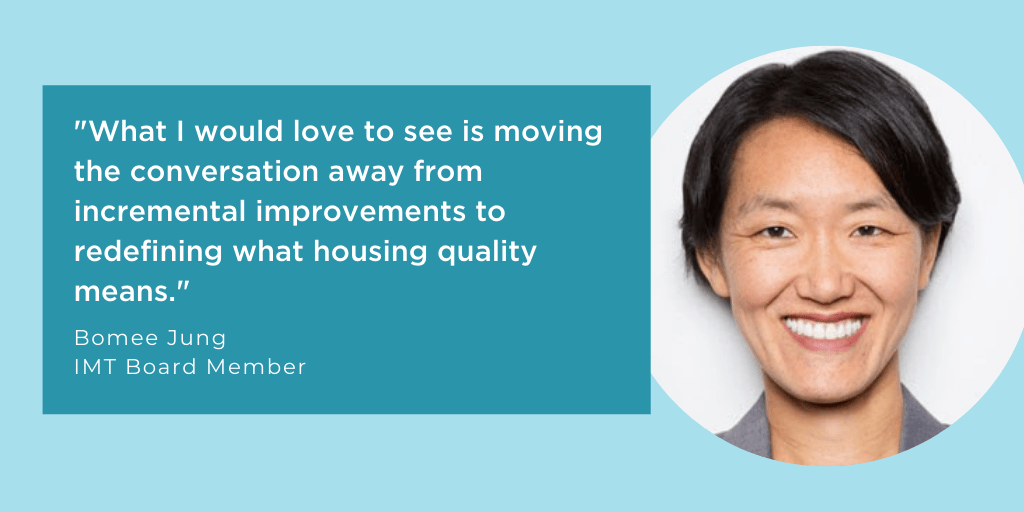In our last interview, you talked about some of the misconceptions around affordable housing and also about a false either/or between energy improvements and affordability. Today, let’s focus on some examples of solutions.

What lessons can we learn from projects and programs that have gotten it right?
New York’s Local Law 97, which sets building carbon emissions limits, has effectively established a carbon price. Now you know what noncompliance will cost you, and that cost can be dropped into the financial models used to assess capital projects. It has created a situation in which people must now make decisions of how and when they are going to reinvest in their buildings, taking it out of the theoretical. That’s a big success.
Another New York example, because that’s the city I know best, is the way they have prioritized affordable housing quality. New affordable housing is built to exceed code performance and meet one of several green standards. Subsidy awards are competitive and once you know that other firms are going to be achieving higher building performance, you are more willing to examine how to do that, even if that wasn’t a priority before. In this way, the city has clearly incentivized forward movement because even if you don’t end up taking action, you’ve now at least considered it, and that learning may then be used in another project.
Whenever you ask someone to do something different, there are risks for everyone—political, financial at all levels in the real estate industry, and for the city itself. We’ve done well coming up with tools that mitigate financial risk for owners. We need to talk about de-risking growth for contractors, particularly for small and medium businesses which operate in lower-income communities.
How can NGOs work with cities AND communities to equitably create better housing?
If I had a magic wand, what I would love to see is moving the conversation away from incremental improvements to redefining what housing quality means with all the right stakeholders involved. Housing doesn’t exist in a bubble. We have to look at how it interfaces with other aspects of the built environment—like transportation and the grid—that are poised to undergo massive transformations in response to climate change. Past evolutions of building and housing quality followed crises—the great fires of the 19th Century, cholera epidemics, etc.—what we are facing in the climate emergency is a much greater crisis. Housing ought to evolve.
Secondly, the community development field can use what it has learned over the past 30-40 years and make it available to other fields. For example, community development corporation (CDCs) are the backbone of the affordable housing industry and often have grassroots leaders who came from the communities where they operate. Over decades, many CDCs have become high-performing real estate organizations while staying rooted in the community. They now participate in the economic system from a position of power. If you try to make change without community-rooted intermediaries, then you don’t know who should speak for frontline communities. If you want to share power and make well-informed decisions, you need a way for conversations to happen from a position of power. There is a lot to learn from community-based and participatory planning, and CDCs really exemplify that grassroots leadership. CDCs could be a great asset to communities in, for example, ensuring that the energy sector’s transition is equitable.
How can policy support more and better quality affordable housing?
We need to write policy that produces the results we want, which right now ought to be a speedy and just transformation in response to the climate emergency. From a developer’s perspective, they need enough money to do the work, but the policy decisions also drive how developers and designers spend their time. Do we want them to spend their time trying to justify why they need to use this slightly more expensive technology? Or do we want them to spend their time trying to figure out what assemblage of technology and construction means and methods will get them the best quality building we know how to build? So policy can bring that into focus, whether via sticks (adding carbon performance requirements) and/or via carrots (more subsidy for low-carbon buildings), and also in how the program goals are framed.
How do we scale up when we know we have cultural resistance to building any affordable housing, let alone higher quality affordable housing?
It’s a terrible conundrum in our culture. If we step back, though, everyone wants economic activity in their city because that’s what provides the tax base for services. From that angle, there is always going to be business interest in participating. Affordable housing is critical economic infrastructure. For example, corporations that are the largest employers in smaller cities recognize that if your workers can’t afford to live where they work, it’s going to make it hard to attract talent. The challenge is to work across industries in ways that really expand the benefits of affordable housing beyond the residents of a particular building.
In terms of scale, I think local governments have a tremendous opportunity to promote valuable learning that will lower risks for everyone in trying new strategies like building electrification. Municipal buildings, which are often class B or C, and public housing are great starting places for building performance improvements. If the construction market can grapple with those, they get experience that can then be used for other clients. As a contractor, if you do an electrification project, you won’t unlearn that. And the contractor who works on electrification of a public housing building may go on to do a private multifamily building next. Contractors who see the opportunity can turn it into a competitive advantage for their businesses. Additionally, I think that it is right for states to consider taking the lead on policies that affect housing costs, particularly where it’s necessary to uphold fair housing access, whether with sticks (Massachusetts) or with carrots (New York).